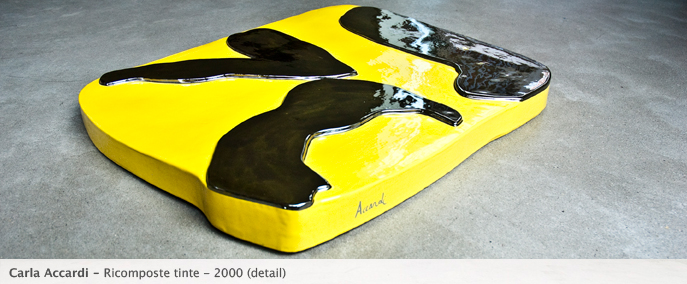

Bio
Cara Accardi
Born in 1924 in Trapani (Italy). Died in Rome, 2014.
After graduating from high school, she went to the Academy of Fine Arts in Florence, which she left to move to Rome. In 1947, together with Attardi, Consagra, Dorazio, Guerrini, Perilli, Sanfilippo and Turcato, she drafted the Forma 1 manifesto with which the young artists reconciled abstract art and civic engagement. Her first solo show was at the Age D’Or gallery in Rome in 1950, with a presentation by Giulio Turcato. In 1951 she participated in the exhibition “Abstract and Concrete Art in Italy” at the National Gallery of Modern Art in Rome. From 1953 she embarked on a new research based on the poetics of sign. In 1959 she held two solo exhibitions: one in Rome at Galleria La Salita and the other in Turin at Galleria Notizie, both accompanied by a presentation by Michel Tapié. In 1964 she is present at the Venice Biennale with a solo room. She develops the research based on the dialectical sign-color relationship, begun in the 1950s, by experimenting with new techniques and materials other than conventional ones such as transparent sicofoil. Made by transparent sicofoil are the painted surfaces of the environments made since the mid-1960s: 1965 Tenda, 1969 Triplice Tenda, 1967 Ambiente Arancio, 2000 Casa labirinto. She exhibited in a number of important international exhibitions and in all major exhibitions dedicated to Italian art, including: Ambiente/Arte at the 1976 Venice Biennale; Avanguardia Transavanguardia68-77 at the Aurelian Walls in Rome in 1982; Chambres d’Amis in Ghent in 1986; Italienische Kunst 1900/1980 at the Kunstverein in Frankfurt in 1985; Italian Art in the 20th Century at the Royal Academy of Arts in London in 1989; and The Italian Metamorphosis 1943-1968 at the Guggenheim Museum in New York in 1994. She is present at the first edition of Minimalia at Palazzo Querini-Dubois in Venice in 1997, and at subsequent editions at Palazzo delle Esposizioni in Rome in 1998 and at P.S.1 in New York in 1999. In 1988 she participated again in the Venice Biennale with a solo room.
Numerous exhibitions have been dedicated to her by private galleries, such as Salvatore Ala Gallery in New York, Galerie Di Meo in Paris, Galleria Pieroni in Rome, Westend Galerie in Frankfurt, and Galerie Meert Rihoux in Brussels.
Solo exhibitions at public institutions include those at Loggetta Lombardesca, Ravenna (1983); Galleria Civica di Modena (1989); Museo Civico di Gibellina (1990); Castello di Rivoli, Turin (1994); Kunstverein Ludwigshafen (1995). In 1996 she inaugurated the permanent work created in mosaic for the Rome subway. In the same year she was awarded the title of Accademico di Brera in Milan and the honor of Cavaliere di Gran Croce by the President of the Republic in Rome. In 1997 at the Atelier del Bosco in Villa Medici, on the premises of the French Academy in Rome, a cycle of exhibitions conceived by the association for contemporary art Zerynthia was inaugurated with a solo show of her work. In 1999 a monograph edited by Germano Celant was published in the Charta editions of Milan. An exhibition at the Castello di Rivoli in 1998, at the Kunstmuseum in Bonn in 1999 and at P.S.1 in New York in 2001 is dedicated to the artwork Triplice Tenda. An exhibition at Galleria Massimo Minini in Brescia with works in sicofoil dates from 2000. In 2002 the Musée d’Art Moderne de la Ville de Paris devoted an extensive anthological exhibition to her. We also remember the exhibition at MACRO Museo d’Arte Contemporanea Roma in 2004, the one in New York at Sperone Westwater Gallery, New York University and Casa Italiana Zerilli-Marimò in 2005, the one at Galleria Valentina Bonomo in Rome in 2007, and among the most recent, the solo show at Haunch of Venison in New York in 2010, the one at Museo Carlo Bilotti and Aranciera di Villa Borghese in Rome in 2011, the one at Macro in Rome in 2015 and the one at Museo del Novecento in Milan in 2020.


